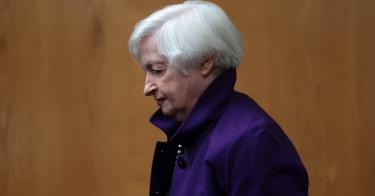Referees aren’t supposed to change the rules in the middle of the game, but that’s exactly what federal government officials like Treasury Secretary Janet Yellen have been doing in financial markets over the last two weeks.
The result is a chaotic mess wherein no one knows what the rules will be tomorrow and no one can plan for the future. What is allegedly a highly regulated sector of the economy feels more like a roll of the dice lately. The economy needs stable banks, which requires stable rules.
Silicon Valley Bank’s collapse earlier this month is the second-largest bank failure in American history, and the federal government’s response has been inconsistent at best.
Regulators previously declared the bank not to be a systemic risk to the banking system, meaning the bank’s potential failure would not pose a threat to the rest of the banking system. Yet when it was clear Silicon Valley Bank would fail, the rules changed and the bank was declared a systemic risk.
On that basis, the Department of the Treasury and the Federal Reserve stepped in to prevent the bank’s liquidation. But they decided to change yet another rule in the process—deposit insurance.
Bank customers’ deposits are ordinarily insured by the Federal Deposit Insurance Corp. up to $250,000, and private insurance is available for additional coverage beyond that. Silicon Valley Bank’s customers chose not to avail themselves of that protection, however, despite over 96% of the bank’s depositors having cash at the bank in excess of the $250,000 FDIC guarantee.
To prevent those large depositors from losing any of their money, the Treasury and the Fed decided to guarantee all deposits at Silicon Valley Bank, despite the fact that the FDIC clearly does not offer unlimited deposit coverage. Millionaires who had their money at the bank are now receiving the benefit of insurance even though they never paid for it.
Imagine a person who could buy flood insurance for his home but chooses not to do so and then the home is destroyed in a flood. That person is not entitled to a bailout from the government—at taxpayer expense.
This unprecedented expansion of FDIC coverage was followed by statements from the Biden administration that Americans could rest assured that all deposits are safe.
But the rules were about to change again. Yellen was asked during her Senate testimony a few days ago whether all depositors at regional banks, like Silicon Valley Bank, are covered by the recent change in the rules regarding the FDIC. Shockingly, Yellen said no.
Only deposits at banks deemed systemically important could be guaranteed coverage, regardless of the size of the deposit. Which regional banks are systemically important? Yellen couldn’t say—that determination would be made on a case-by-case basis going forward. She reiterated this vague canon on Tuesday when she told the American Bankers Association, “Similar actions could be warranted if smaller institutions suffer deposit runs that pose the risk of contagion.” That’s hardly black and white.
Not only have the rules changed again, but now the referees can’t even clearly articulate them. The result has been a flood of large deposits fleeing smaller banks for larger banks that have already been declared systemic risks requiring government support. That cash drain from the smaller banks could put them at risk and precipitate even more problems in the already-troubled banking sector.
One of the reasons for these troubles is because banks are holding so many low-interest rate bonds. But that situation is itself a result of the federal government changing the rules of the game. When the Fed kept interest rates too low for too long in order to finance trillions of dollars in government deficit spending, the yield on bonds plummeted, and the banks buying those bonds took on tremendous interest rate risk.
Those banks were encouraged to continue that behavior because the Fed continued offering forward guidance that rates would remain low and that inflation was transitory. But that narrative changed one year ago, in March 2022, and interest rates began to rise. Just a few months after that initial rate hike, Fed Chair Jerome Powell said a larger 75-basis-point hike was “off the table,” and the Fed promptly followed that pronouncement by delivering four such rate hikes in a row.
It’s no fun if a party host randomly changes the rules of a game when everyone is in the middle of playing. But at least the trouble ends there. When the government changes the rules of banking without warning, the results can be financial disaster that cascades through the economy for years to come.
This piece originally appeared in The Daily Signal




